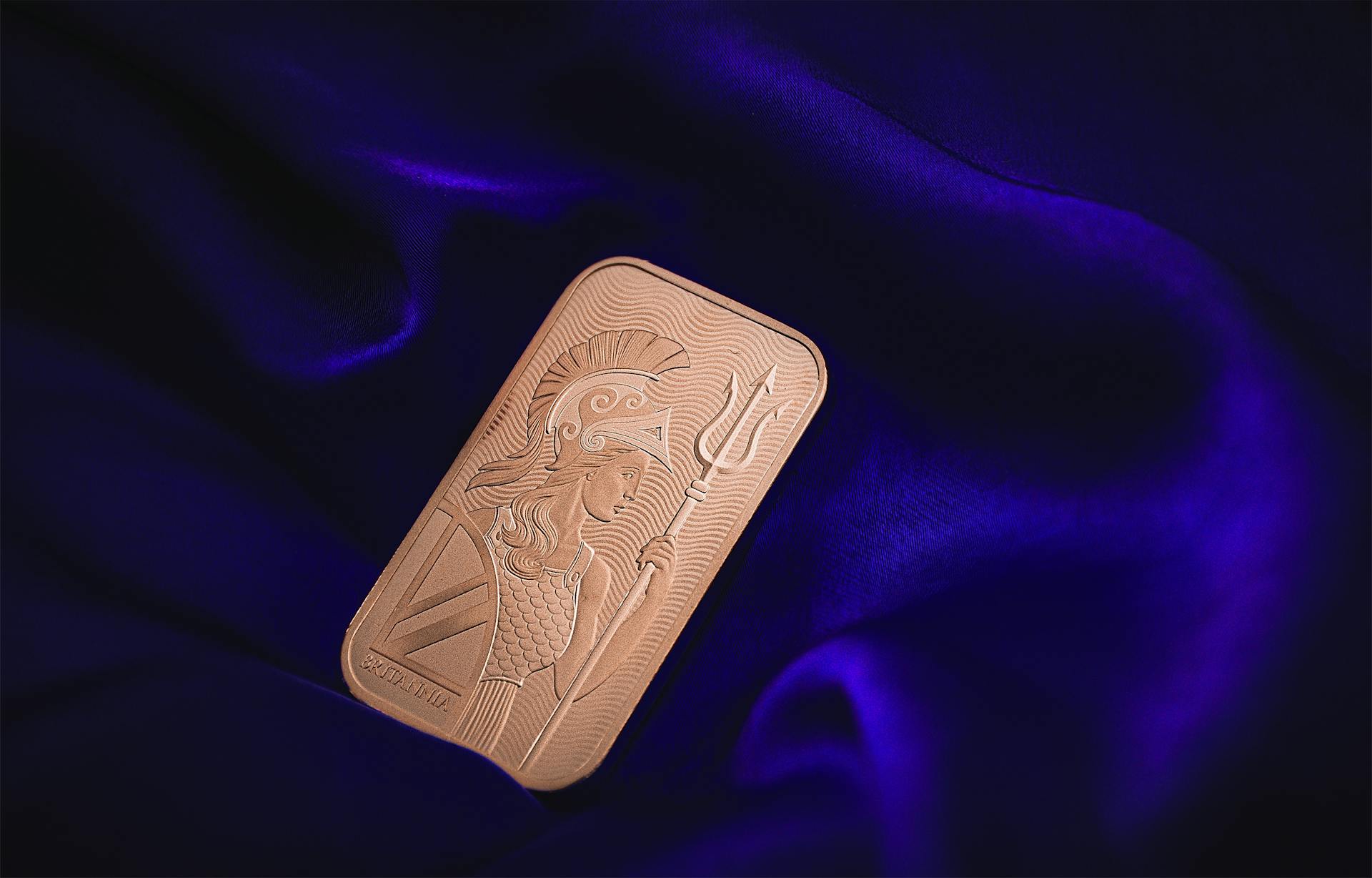
Buying real gold can be a great investment, but it's essential to know what you're doing. Gold coins and bars are the most common forms of physical gold investment.
You can buy gold coins from mints like the U.S. Mint, the Royal Canadian Mint, or the Perth Mint. These mints offer a range of coins in different weights and with various designs.
Before buying, it's crucial to research the purity and authenticity of the gold. Look for coins or bars with a high purity level, such as 24-karat or 99.9% gold.
Why Buy Gold
Buying gold is a smart investment strategy that can provide a safety net for your finances. Gold is a tangible asset that maintains its intrinsic value, making it a reliable store of wealth.
Gold has proven to be a consistent source of value, unlike other currencies that are quickly devalued by inflation and financial instability. This is because gold is not affected by inflation, and its value remains closely tied to the cost of living.
A unique perspective: What Is the Value of a Krugerrand
In times of economic uncertainty, gold often appreciates in value, serving as a hedge against economic disaster. In fact, history has shown that during economic slowdowns, from the Great Depression to the COVID-19 pandemic, gold has consistently appreciated in value.
Investing in gold can be a smart way to diversify your portfolio, especially one that includes stocks, bonds, and mutual funds. Many financial advisors recommend keeping anywhere from 5% to 10% of your portfolio in gold.
Gold acts as a counterweight to stocks, usually moving in the opposite direction of the stock market. For example, when the subprime mortgage meltdown began in 2008, gold shot up from the $400-600 range to $1,000 per ounce and continued for three years.
In uncertain times or socio-political turmoil, gold is seen as a safe haven. Its price rose over 10% in one month after the 2016 Brexit vote, making it an attractive option for individuals concerned about global market collapse or government instability.
Physical gold is virtually indestructible, meaning it cannot be hacked or erased. This makes it a natural choice for those looking for a long-term store of wealth.
Here are some key benefits of owning physical gold:
- Inflation hedge: Gold maintains its intrinsic value, reflecting the cost of living.
- Counterweight to stocks: Gold moves in the opposite direction of the stock market.
- Safe haven: Gold is a reliable store of value in uncertain times.
- Virtually indestructible: Physical gold cannot be hacked or erased.
Understanding Gold
Gold is a rare commodity, making up only 0.003 parts per million of the earth's crust.
This scarcity contributes to its value in the global financial markets, making it a long-standing investment choice.
The yellow metal's desirability plays a significant role in its value, driven by its limited supply and rarity.
Iron, on the other hand, makes up about 50,000 parts or 5% of our planet's crust, highlighting the vast difference in abundance between the two metals.
For more insights, see: Spot Value of Silver Coins
Types of Gold
When buying gold, you have two main types to consider: minted coins and bullion bars.
Minted coins are new, government-issued coins that investors can buy for their gold content.
Some of the most widely recognized minted coins are the American Gold Eagle, Australian Gold Nugget, Canadian Maple Leaf, and South African Krugerrand. These coins are available from major banks, coin dealers, and precious metal dealers.
The gold content in minted coins is typically lower than in bullion bars, with a one-ounce American Gold Eagle coin being only 91.67% gold.
Here are some popular gold coins on the market:
- Canadian Maple Leaf
- Gold Britannia Coin
- Krugerrand
Coins and Collectibles
Gold coins are another popular way to invest in physical gold. They're minted by governments for investors and their prices are based on their gold content, plus a 1%-5% premium.
Some of the most widely circulated and recognized gold coins include the American Gold Eagle, Australian Gold Nugget, Canadian Maple Leaf, and South African Krugerrand. These coins are available from major banks, coin dealers, brokerage firms, and precious metal dealers.
Investors often prefer gold coins because they're internationally recognized and can be easily sold or traded. In fact, the American Gold Eagle is guaranteed by the federal government, which means dealers have to buy them and can't pull any shenanigans.
Here are some of the most popular gold coins on the market:
- American Gold Eagle
- Australian Gold Nugget
- Canadian Maple Leaf
- South African Krugerrand
Keep in mind that gold coins typically have a lower percentage of gold content than gold bars, with a one-ounce American Gold Eagle coin being only 91.67% gold. Always ensure that the gold you buy is approved by the London Bridge Market Association and is at least 99.9% pure, which is the standard investment grade.
Jewelry
Gold jewelry is a popular alternative to buying gold coins and bullion bars, but be cautious of the premium prices that come with it.
Gold jewelry manufacturers often use alloys to enhance durability or change the color of the jewelry.
The price of gold jewelry includes a premium that can be considerable, so weigh up the value of your investment carefully.
Gold is measured in terms of purity, denoted by its karat value, with 24 karats being pure gold but too soft for most practical applications.
Most jewelry is around 18 karats or 75% purity, making it a durable option for everyday wear.
To ensure you're getting a good deal, make sure the seller is reputable and trustworthy, providing documentation that authenticates the quality of the gold jewelry.
For another approach, see: 1976 Krugerrand Gold Coin Value
Advantages and Disadvantages
Buying real gold can be a smart move, especially in uncertain times. Physical gold is a tangible asset that maintains its value over time, making it a great inflation hedge.
Gold is also a counterweight to stocks, often moving in the opposite direction of the market. For example, when the subprime mortgage meltdown began in 2008, gold shot up from the $400-600 range to $1,000 per ounce and continued to rise for three years.
One of the advantages of physical gold is its safety. It can't be hacked or erased, and even natural disasters can't destroy it. Here are some key advantages and disadvantages of physical gold:
- Inflation hedge
- Counterweight to stocks
- Safe haven
- Virtually indestructible
However, it's worth noting that physical gold can be less liquid than other investments, and it requires a higher initial investment compared to gold securities.
Is a Good?
Gold can be a good investment for long-term investors, especially if they can buy in at a low price due to a rising-rate environment.
Since 1971, gold returns have been similar to equities and outperformed bonds, according to the World Gold Council.
Gold is typically seen as an uncorrelated asset, meaning its price doesn't necessarily follow the trends of other asset classes.
Related reading: What Does Silver Spot Price Mean

It can balance out your other holdings and protect against downside if stocks or the U.S. dollar are slumping, acting as a diversifier in your portfolio.
Gold can play a complementary role in investor holdings, at between 2% to 10% of a portfolio, according to Milling-Stanley.
There is roughly $150 billion in daily turnover in gold, more than U.S. Treasury bills, and world central banks view gold as a key holding.
The strength of the U.S. dollar and bonds paying out high interest rates can put gold on the back burner, but for long-term investors, this could mean an attractive buying price.
Advantages and Disadvantages
Physical gold has several advantages, including serving as an inflation hedge, acting as a counterweight to stocks, and being a safe haven in uncertain times. It's virtually indestructible and can't be hacked or erased.
Gold is not a smooth ride, with its price fluctuating over the years. Since 1971, returns have been similar to equities and outperformed bonds.
One of the main benefits of gold is its ability to balance out other holdings in a portfolio. It's typically seen as an uncorrelated asset, which means it doesn't necessarily do what other asset classes are doing.
Here are some key characteristics of gold:
- Inflation hedge
- Counterweight to stocks
- Safe haven
- Virtually indestructible
However, physical gold also has some disadvantages, including being expensive to hold and store, and not producing income or profit. Shipping, insurance, and storage can affect your bottom line, and physical gold can get lost or stolen.
Gold securities, on the other hand, offer more liquidity than physical gold and can earn dividends. They also have a low initial investment requirement.
Take a look at this: How to Buy Gold Bars in Usa
Storage and Security
Storing your gold safely is crucial to protect your investment.
You should consider insuring your gold and locating an off-site storage location to prevent theft.
Storing gold at home is not recommended, as it leaves you vulnerable to theft.
If you want to hold gold in an IRA account, the IRS mandates that gold can be stored with a metals-specialist custodian through a gold IRA.
You can also consider using private vaulting facilities, which offer secure logistics and extensive security measures.
A professional gold storage company can handle the logistics of hauling and transferring large or even small amounts of gold.
Here are some storage options to consider:
Purchasing Physical
Purchasing physical gold requires careful consideration to ensure you get the real deal. Always purchase from reputable sellers only, as you can never be too sure about the authenticity of the gold.
Investing in gold bullion is the most common way to invest in physical gold. Gold bullion typically ranges from 1/10 troy ounce to one kilogram, and it's always at least 99.5 per cent pure.
Gold bars will have the manufacturer's name, weight, and purity stamped on them, making it easier to verify their authenticity. This is especially important when buying online, where it's harder to check the gold's purity.
Physical gold can be purchased from banks or brokers, but it's generally best to buy from trusted local sources. Purchasing gold in Singapore is also advantageous, as it's an Investment Precious Metal (IPM), exempt from Goods & Services Tax (GST).
You might enjoy: Gold Bullion as an Investment
Investing in gold jewellery is not the same as actual gold investment, as it includes costs like craftsmanship and branding that are extrinsic to its gold content. This means you'll pay more for the design and branding than the actual gold value.
If you do decide to invest in gold jewellery, make sure to store it securely, as it's not categorized as an IPM and is subject to GST.
A fresh viewpoint: Buy Silver and Gold Not Phisical
Storage
Having a storage plan is crucial when it comes to gold ownership. Stashing large amounts of gold in your home leaves you vulnerable to theft.
To mitigate this risk, consider insuring your gold and locating an off-site storage location where it can be protected. If you want to hold gold in an IRA account, the IRS mandates that gold can be stored with a metals-specialist custodian through a gold IRA.
Switzerland is a secure jurisdiction for storing gold, and even during times of war, the Swiss government has no authority to seize gold. This makes it an attractive option for those looking to store their gold offshore.

Private vaulting facilities, such as those offered by Rotbart, provide a secure and convenient option for storing gold. They have extensive experience securely transporting clients' gold to and from storage facilities.
However, storing gold can be expensive, with costs ranging from 0.5% to 2% of the holdings' value. Additionally, physical gold is illiquid, meaning it can't be sold quickly or easily.
Here are some of the drawbacks of physical gold storage:
- Expensive to hold
- Illiquid
- Does not produce income or profit
Securities
Securities can be a more convenient and practical choice for novice investors, especially when compared to the hassles and limits of bullion.
Investing in gold securities, such as stocks or funds, can be a more straightforward option for those new to investing.
Given the flexibility and accessibility of gold securities, they can be a great starting point for building a gold investment portfolio.
For example, gold securities in the form of stocks can provide a more liquid investment option, allowing investors to easily buy and sell their shares.
You might like: Gold Stocks Etf

This can be particularly appealing to those who want to diversify their portfolio or adjust their investment strategy as needed.
Investors should carefully consider their goals and risk tolerance before investing in gold securities, as they can be subject to market fluctuations.
Ultimately, gold securities can offer a more practical and convenient way to invest in gold, especially for those who value ease and flexibility.
Investment Options
You can invest in gold through various means, including purchasing physical gold, gold-linked currency investments, and gold ETFs or unit trusts.
Physical gold comes in many forms and sizes, each with its own characteristics and costs.
Some investors prefer to buy shares in gold-oriented mutual funds or exchange-traded funds (ETFs), which offer a liquid, low-cost entry into the gold market that is more diversified and lower-risk than buying equities outright.
Here are some popular gold investment options:
- Purchasing physical gold
- Gold-linked currency investments
- Gold ETFs or unit trusts
- Gold mining stocks
Gold ETFs, like SPDR Gold Trust (GLD) and iShares Gold Trust (IAU), are funds that trade like stocks, allowing you to gain exposure to gold with ease.
Related reading: I Shares Silver Trust Stock Price
Buying Options

If you're considering investing in gold, you have several buying options to choose from. You can start by purchasing physical gold, which comes in various forms such as coins, bars, or jewelry.
Physical gold can be a tangible and secure investment, but it also requires storage and insurance.
If you prefer a more liquid investment, you can opt for gold-linked currency investments, which allow you to invest in gold without directly owning it.
Gold-linked currency investments are often denominated in grams or ounces of gold, and their value is tied to the price of gold.
Another option is to invest in gold ETFs or unit trusts, which allow you to buy a small portion of a gold fund.
Gold ETFs or unit trusts offer the benefits of diversification and liquidity, but also come with management fees.
Finally, you can invest in gold mining stocks, which give you exposure to the gold mining industry.
Gold mining stocks can be volatile, but they also offer the potential for long-term growth.
Here are the different buying options for gold:
- Purchasing physical gold
- Gold-linked currency investments
- Gold ETFs or unit trusts
- Gold mining stocks
Mutual Funds

Mutual funds favor gold mining stocks and offer a liquid entry into the gold market.
These funds provide a more diversified and lower-risk investment compared to buying equities outright.
Some mutual funds invest in both gold mining stocks and physical gold, but they all offer a low-cost entry into the gold market.
By investing in mutual funds, you can gain exposure to the gold market without directly buying physical gold or equities.
This can be a more conservative approach for investors who want to spread their risk and diversify their portfolio.
Explore further: How Can I Buy Physical Gold
ETFs
ETFs offer a convenient and low-cost way to invest in gold. You can buy shares in gold-oriented mutual funds or exchange-traded funds (ETFs), which provide a liquid entry into the gold market.
Large ETFs, such as the SPDR Gold Trust (GLD), are easy to trade in and out of, and ideally will charge low management fees. The SPDR Gold Trust has $53 billion in investor assets, backed by actual physical gold.
Check this out: Gold Trust Etf

Some ETFs, like the SPDR Gold Trust, incur costs such as transporting, insuring, and storing gold bars. However, these costs are often lower than those associated with traditional funds.
You can also consider smaller ETFs, like the SPDR Gold MiniShares (GLD), which offers a rock-bottom fee of 0.1% that can appeal to cost-conscious investors.
Here are a few examples of popular gold ETFs:
- SPDR Gold Trust (GLD) with $53 billion in investor assets
- iShares Gold Trust (IAU) with almost $25 billion in assets and an annual fee of 0.25%
- SPDR Gold MiniShares (GLD) with a low annual fee of 0.1%
Sources
- https://www.businessinsider.com/personal-finance/investing/how-to-invest-in-gold
- https://www.sc.com/sg/wealth/insights/how-to-invest-in-gold/
- https://www.wsj.com/buyside/personal-finance/financial-tips/how-to-buy-gold
- https://www.moneyunder30.com/how-to-invest-in-gold/
- https://nomadcapitalist.com/finance/investing/how-to-buy-gold/
Featured Images: pexels.com


